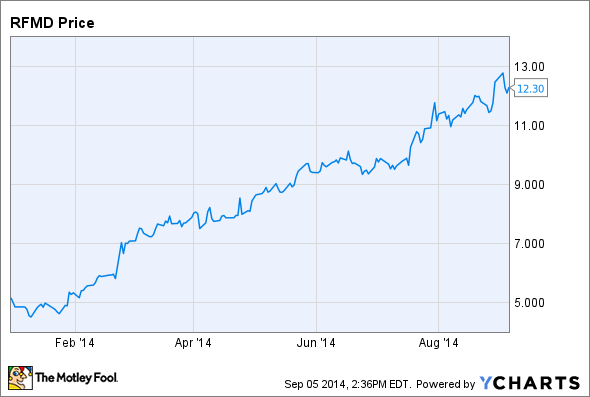RF Micro Devices (NASDAQ: RFMD), a supplier to smartphone vendors such as Apple and Samsung, has seen its stock rise nearly 150% in 2014. The company's most recent earnings report handily beat analyst estimates, and the company's profitability has improved dramatically compared with last year. Even after this epic rise, there are still a few reasons to believe that the stock could continue to go higher in the long term.
Continued success of the iPhone
The annual launch of a new iPhone from Apple brings with it speculation regarding which component suppliers will benefit the most. RF Micro managed to increase its presence during the last iPhone launch in 2013, and strong guidance from the company suggests that the upcoming iPhone 6 could be very good for the company as well.

iPhone 5S. Source: Apple.
iPhone sales haven't showed signs of slowing down, even as Apple's iPad sales have suffered from multiple quarters of declines. In Apple's most recent quarter, iPhone unit sales jumped 13% year over year, and with the iPhone 6 expected to come in larger sizes than previous iPhones, analysts are expecting sales to outpace the iPhone 5s.
Apple is certainly facing threats in the long term from less expensive Android-based competition, but the iPhone remains extremely popular, especially in the United States, where it enjoys a market share in excess of 40%. As long as Apple can keep growing iPhone sales -- which is possible even as it loses global market share, since the smartphone market is still growing -- RF Micro stands to benefit.
The Internet of Things
While the rapid growth of mobile devices has been impressive, it could pale in comparison with the growth expected from devices excluding PCs, tablets, and smartphones collectively making up the Internet of Things, or IoT. Gartner expects there to be 26 billion IoT devices by 2020, far more than the 7.3 billion PCs, tablets, and smartphones expected to be in use at that time.
The opportunity for RF component companies like RF Micro could potentially be enormous, as all of those 26 billion devices will need to be connected to the Internet. We're starting to see the beginnings of this trend today, with products such as the Nest smart thermostat helping people save on their electricity bills, along with the coming glut of smartwatches and other wearable devices.
It will be up to RF Micro to take advantage of this opportunity, but its total addressable market is set to grow substantially in the coming decades. If RF Micro can achieve the same success it's had in the smartphone market, then the company's revenue, profit, and stock price could surge in the long term.
Merger with TriQuint
RF Micro isn't the largest RF component company, and its lack of scale has been partly responsible for a mixed record of profitability over the past decade. But the announced merger with TriQuint, a company roughly the same size as RF Micro in terms of revenue, will create a larger company that will be better able to better take advantage of the growth opportunities before it. While TriQuint has been unprofitable for the past two years, RF Micro expects the transaction to be accretive to non-GAAP EPS during the first full fiscal year following the close of the deal.
RF Micro expects to achieve $150 million in cost synergies from the merger, and that should help boost profitability for the combined company. During RF Micro's most recent quarter, both gross margin and operating margin soared year over year, and the company can grow earnings going forward not only by growing revenue, but also by increasing margins at TriQuint up to the same level as the rest of the company.
Integrating TriQuint will take time, but if the company can reach the level of cost savings that management has laid out, earnings for the combined company would be substantially higher than the total earnings of both companies today.
Final thoughts
RF Micro needs to successfully take advantage of the opportunities available to the company, and there is certainly plenty that could go wrong. But the continued success of high-end phones like the iPhone, the rise of the Internet of Things, and the merger with TriQuint could all drive both earnings and the stock price higher in the long term.





